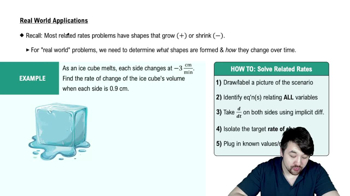Table of contents
- 0. Functions7h 52m
- Introduction to Functions16m
- Piecewise Functions10m
- Properties of Functions9m
- Common Functions1h 8m
- Transformations5m
- Combining Functions27m
- Exponent rules32m
- Exponential Functions28m
- Logarithmic Functions24m
- Properties of Logarithms34m
- Exponential & Logarithmic Equations35m
- Introduction to Trigonometric Functions38m
- Graphs of Trigonometric Functions44m
- Trigonometric Identities47m
- Inverse Trigonometric Functions48m
- 1. Limits and Continuity2h 2m
- 2. Intro to Derivatives1h 33m
- 3. Techniques of Differentiation3h 18m
- 4. Applications of Derivatives2h 38m
- 5. Graphical Applications of Derivatives6h 2m
- 6. Derivatives of Inverse, Exponential, & Logarithmic Functions2h 37m
- 7. Antiderivatives & Indefinite Integrals1h 26m
- 8. Definite Integrals4h 44m
- 9. Graphical Applications of Integrals2h 27m
- 10. Physics Applications of Integrals 2h 22m
4. Applications of Derivatives
Related Rates
Problem 13c
Textbook Question
The legs of an isosceles right triangle increase in length at a rate of 2 m/s.
c. At what rate is the length of the hypotenuse changing?
 Verified step by step guidance
Verified step by step guidance1
Identify the relationship between the sides of an isosceles right triangle. The legs are equal, and the hypotenuse can be found using the Pythagorean theorem: \( c = \sqrt{2}a \), where \( a \) is the length of each leg and \( c \) is the hypotenuse.
Differentiate the Pythagorean theorem with respect to time \( t \) to find the rate of change of the hypotenuse. Start with \( c^2 = a^2 + a^2 = 2a^2 \).
Apply implicit differentiation to \( c^2 = 2a^2 \) with respect to \( t \): \( 2c \frac{dc}{dt} = 4a \frac{da}{dt} \).
Solve for \( \frac{dc}{dt} \), the rate of change of the hypotenuse: \( \frac{dc}{dt} = \frac{2a \frac{da}{dt}}{c} \).
Substitute the given rate of change of the legs \( \frac{da}{dt} = 2 \) m/s and the expression for \( c = \sqrt{2}a \) into the equation to find \( \frac{dc}{dt} \).
 Verified video answer for a similar problem:
Verified video answer for a similar problem:This video solution was recommended by our tutors as helpful for the problem above
Video duration:
2mPlay a video:
Was this helpful?
Key Concepts
Here are the essential concepts you must grasp in order to answer the question correctly.
Isosceles Right Triangle Properties
An isosceles right triangle has two equal sides and a right angle between them. The lengths of the legs are denoted as 'a', and the hypotenuse 'c' can be calculated using the Pythagorean theorem: c = a√2. Understanding these properties is essential for relating the sides of the triangle to each other.
Recommended video:

Properties of Functions
Related Rates
Related rates involve finding the rate at which one quantity changes in relation to another. In this problem, we need to determine how the length of the hypotenuse changes as the lengths of the legs increase. This requires applying differentiation to the relationship between the sides of the triangle.
Recommended video:

Intro To Related Rates
Differentiation
Differentiation is a fundamental concept in calculus that deals with finding the rate of change of a function. In this context, we will differentiate the equation relating the legs and the hypotenuse with respect to time to find the rate at which the hypotenuse is changing as the legs grow.
Recommended video:

Finding Differentials
Related Videos
Related Practice





